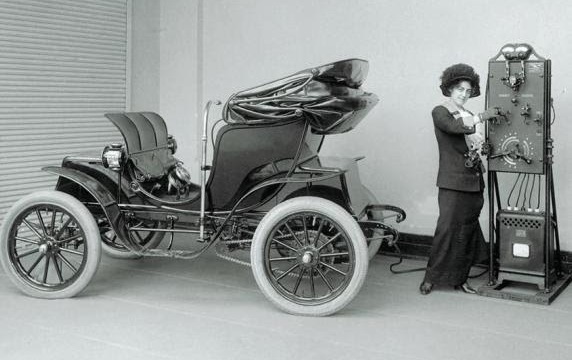Electric cars in Turin at the beginning of the 20th century

They were abandoned when the petrol engine triumphed on the market, noisier and more polluting but allowed you to travel greater distances in less time.
At a certain point the blue thinned out, a clear, precise landscape emerged. Hector found himself on the street of a city, driven by electric cars, at least a hundred years old.” This is how Paolo Aresi , author of science fiction novels, imagines a dystopian future. Yet, this is not fantasy, it is history. Electric cars older than a century exist and drove along the streets of Turin at the beginning of the twentieth century, driven by elegant ladies.
At that time, various workshops were making hybrid and electric-powered cars , technologies that seemed to adapt very well to urban roads but which were soon abandoned when the petrol engine triumphed on the market , noisier and more polluting but which allowed you to travel greater distances in less time.
Since the beginning of the 1860s, there has been talk of applying the first electric motors to wheeled vehicles. The reason is simple, at the time steam vehicles were bulky, expensive and heavy and few could afford a vehicle that required the use of three or four people. Furthermore, they risked colliding with horse-drawn carriages. Compared to the steam engine and the internal combustion engine, the electric engine appeared the most promising, for several reasons. Firstly, because it was a simple technology to use: all you had to do was press a button or pull a lever to activate it.
The internal combustion engine was more complicated, as Davide Lorenzone, curator of the National Automobile Museum , explains : “The ignition was not yet constant, they were noisy and sometimes they exploded. Even finding petrol was almost impossible. The only place where you could buy them was the pharmacy where they provided ten liter cans. There were no filling stations.” Instead, with the electric motor and charged batteries, you could travel the entire city.
An advertisement for an electric car from Turin from the early twentieth century announced that it could travel from 80 to 100 km on a single charge. They were lead batteries and the manufacturing companies gave them the possibility of recharging them in the factory or special panels were sold , which could be installed near homes or companies. As did the textile industrialist Napoleon Leumann who used only hybrid vehicles for his transport.
A major problem of early urban mobility was the noise of steam and combustion engines which frightened carriage horses. Otherwise, electric cars were silent and for this reason they were used as public transport when the first taxi service was born under the masses. Those cars were simple to drive, elegant to admire and looked perfect for the ladies. From a 1906 catalog of «Dora», the Alpignano company that produces electric cars and accumulators, we read: “Electric cars are the best suited for the city, because they do not require too heavy a mechanism for their construction, they are more streamlined and therefore more elegant, they parade silently , and they do not pollute the air with emanations of burnt oil and petrol, therefore rightly preferred by our ladies who can appear splendidly on them during public walks.”
Electric mobility was not only widespread in Piedmont, from the documents in the archive of the Turin Automobile Museum (where some ancient electric cars are on display) it emerges that in Manhattan already in 1910 there were 44 charging stations and some shopping centers even had car charging areas on the ground floor. People thus had the opportunity to charge their cars while doing errands and shopping. The green future of mobility seemed to be sealed, non-polluting and silent cars would make expanding urban centers more livable. Yet, in Turin almost all electric car manufacturers closed their doors between 1915 and 1916. The car manufacturing companies decided to bet all their cards on the petrol engine which had been perfected in the meantime. Engines that respond to the needs of modernity: faster, more performing and which allow you to travel long distances even outside urban centres, where roads increasingly suitable for cars are starting to spread. The internal combustion engine thus takes over and electric car manufacturing companies see no outlets for a technology that was considered obsolete at the time and which appears to us today as innovative.
Davide Lorenzone concludes: “At the beginning of the twentieth century, several factories were founded in Turin that produced electric vehicles and in the first decade of the last century those cars were widely sold. There were also hybrids with a second motor that recharged the battery while the vehicle moved. Nothing was invented, everything was already invented more than 100 years ago.”
AUTHOR
Dario Basile
Electric cars in Turin (computer translation)
©2023. Wallace Bruschweiler. All rights reserved.
RELATED ARTICLES:
Before Tesla: Why everyone wanted an electric car in 1905
Worth the Watt: A Brief History of the Electric Car, 1830 to Present


Leave a Reply
Want to join the discussion?Feel free to contribute!